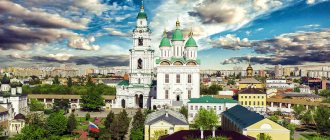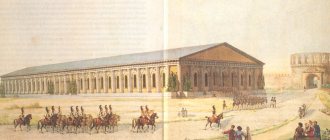“Moscow Courtyard” is the most famous of Vasily Polenov’s paintings. An idyllic view of old Moscow, where the slender architectural beauty of churches coexists with patriarchal everyday life, a tented bell tower coexists peacefully with a rickety barn, and everything depicted is a two-story mansion with an empire-style facade and tin drainpipes, a cheerfully green lawn in the backyard, paths cutting it, harnessed to a horse waiting for the owner, a hurried female figure with a bucket in hand, busily walking chickens, a well, burdocks under the fence and laundry on the lines, slopes of roofs in the background and trees growing chaotically without the intervention of a gardener, children playing and a desperately roaring baby that does not in any way disturb the general blissful mood, birds in the sky and rare clouds - everything is immersed in a single air environment permeated with the sun. The bright plein air painting, so different from Polenov’s contemporary genre painting of the Itinerants, makes us talk about “Moscow Courtyard” as the first proto-impressionist painting in Russian art.
History of creation
In June 1877, Vasily Polenov moved from St. Petersburg to Moscow and began renting an apartment at the address: Moscow, Durnovsky lane near Spas na Peski, Baumgarten house (possession 148), located on the corner of Durnovsky and Trubnikovsky lanes. Looking from the window of his apartment, he wrote a sketch for the landscape “Moscow Courtyard”. Polenov described the story of the creation of the painting this way: “ I went to look for an apartment. I saw the note, went in to have a look, and I saw this view right from the window. I immediately sat down and wrote it
».
The sketch was rewritten on canvas (the angle was slightly changed and the view was expanded), and people were added to the courtyard. Vasily Polenov sent this painting to St. Petersburg for the exhibition of Itinerant artists in 1878. He wrote to Ivan Kramskoy: “ Unfortunately, I did not have time to do a more significant thing, but I wanted to appear at a traveling exhibition with something decent. I hope in the future to earn back the time lost for art. My picture depicts a courtyard in Moscow at the beginning of summer
" The painting by Vasily Polenov was a great success at the exhibition and brought fame to the artist. Soon after the exhibition, Pavel Tretyakov acquired the painting for his gallery.
What is shown in the picture
The canvas “Moscow Courtyard” by Polenov depicts a city landscape. The picture can be roughly divided into three plans - foreground, middle ground and sky. In the foreground and center is a vacant lot overgrown with short green grass. There are two intersecting roads running through the wasteland, which are located diagonally relative to the plane of the picture. Several children are playing in the vacant lot; one child sits on the grass and cries loudly.
To the left of the vacant lot at the end of one of the roads there is a wooden well, which is covered with a lid on top. To the left of the well we can see part of a wooden fence, behind which there are many trees (perhaps an overgrown garden). To the right of the vacant lot (already in the middle ground) at the end of one of the roads we see a harnessed horse waiting for its owner. Next to the horse is a peasant house or technical outbuilding.
In the middle ground on the left we can see a two-story white mansion with tin drainpipes. The canvas depicts only a piece of the mansion - most of the house is hidden by trees, and part of the building completely extends beyond the canvas. Near the mansion we can see a woman who is probably the mother of children playing. The mother is holding a bucket of water in her hand, and her gaze is most likely fixed on the crying child. Next to the mansion there is a technical wooden extension.
Several peasant houses and technical outbuildings are also depicted in the middle ground. On the left we can see the church domes and spire that belong to the Church of the Savior in Peski near Arbat (the temple still exists today). To the right of the church you can see another mansion, next to which there are several deciduous trees and a fence. Above all this rises the blue expansive sky. There are several white clouds in the sky, which are concentrated mainly in the center and on the right edge of the canvas.
Links
- “Moscow courtyard” in the Tretyakov Gallery database
- Moscow courtyard, www.nearyou.ru
- Magazine “Tretyakov Gallery” #3 2013 (40), section “MASTERPIECES OF RUSSIAN ART”, Eleanor Paston, “Moscow, how much there is in this sound...”
| Works by Vasily Polenov | |
| |
Description of the picture
The basis of the canvas is a courtyard standard for old Moscow; it reflects the special spirit of the time, the patriarchal way of life. The artist reflected the summer period, the heat of the daytime sun is felt, and flowering is visible. The beauty of the cozy street is emphasized by the blue sky, which frames the elegant church with domes.
A bell tower lies nearby, the brightness of the sunlight reflects the presence of shadows from the clouds. The center of the courtyard is reserved for a mansion; its antiquity is highlighted by the presence of very old outbuildings and a collapsed barn roof. The well has also seen a lot; it has already squinted.
With the age of the furnishings and architecture, the flow of life is reflected, there is a harnessed horse in the picture, and chickens are also looking out here and there. A woman walks by in the distance with a bucket, it looks full. Perhaps this is how the artist wanted to show that the local residents are not afraid of troubles.
The blond children are closest to the viewer, a couple of them are located on the grass, the girl pays attention to the flower. Everyone here is busy with their own business, no one has time to pay attention to the crying baby.
At that time, the courtyard was ordinary, life here was simple, it went smoothly. Although the neglected buildings are drawn, there is not a drop of drama in the drawing. Children also reflect the continuation of life, the artist was able to show his merciful reflection towards people, and the tranquility of the passage of summer time.
Artistic techniques
The composition is well thought out, although this is not immediately visible; there is a conventional division into the earthly world, like paradise, it is located in the lower part of the work. The upper part is heaven with clear skies, clouds, church. The tones contain all the colors used in the world atlas, perhaps this is how it is shown that this courtyard is a whole world for the local residents. Only up close can you see that the grass is drawn using different tones and transitions, every detail was drawn with close attention. The coloristic side of the painting is interesting; clean and fresh tones convey the joy of life; even for the shadows the artist did not use dull tones.
LiveInternetLiveInternet
Quote from Barucaba
Read in full In your quotation book or community!
Moscow courtyard
for Kadzhanlino
Vasily Polenov. Moscow courtyard.
1878. Oil on canvas. Tretyakov Gallery, Moscow, Russia.
This is a favorite picture of many generations of viewers. Polenov depicted a typical corner of old Moscow - the Church of the Savior on the Sands, located in one of the alleys near the ancient Arbat Street. This church still stands today, now surrounded by a completely different urban environment. In the picture we see buildings characteristic of the 18th – 19th centuries. The main urban planning unit of Moscow was not the streets and squares, but the house and the courtyard. Old Moscow mansions, sometimes occupying entire blocks, were surrounded by gardens with fruit trees and outbuildings. These “noble nests” were a model of traditional village life, which is why Moscow was often called the “big village.” Polenov created an image full of peace and tranquility. Painted in bright colors, the picture affirms the joy of everyday life – “gratifying”, in the words of the artist Serov, and conveys the bright feelings of the author.
Now, today this place will be very difficult to find, because this house and courtyard no longer exist.
Polenovsky's Moscow courtyard was painted in the Arbat area, in the area just above where the Oktyabr cinema is now located. Those. closer to Smolenskaya. Vasily Dmitrievich Polenov wrote on June 23, 1877 to his uncle Chizhov, in whose house he had been living for three weeks and was looking for an apartment in Moscow: “Dear uncle, thank you for your hospitality, etc. My new home is very close to you. It is located in Durnovsky Lane between Novinsky Boulevard and Sobachya Ploshchadka. My address: Moscow, Durnovsky Lane near Spas na Peski, Baumgarten House.”
And the Dog Playground, a cult place, and other Arbat alleys between Bolshaya Molchanovka and Arbat itself were swept away by the New Arbat clearing. Durnovskaya Street, now simply Kompozitorskaya Street, ran right between this site and Novinsky Boulevard. And nearby was Durnovskoy Lane. The famous Moscow architectural critic Maria Nashchokina said that this house was on the site of the current house No. 17 on Kompozitorskaya Street. Now this is Trubnikovsky Lane, house No. 5, which is indicated by a fraction: 5/17. And now No. 17 is Kompozitorskaya Street, which includes Durnovsky Lane and Sobachya Ploshchadka. The street became Kompozitorskaya (and this is obvious) thanks to the Gnessin sisters and the school of the same name, plus everything in the same place used to be the Composers’ Union.
Both the bell tower and the church depicted in the picture have been preserved; the interior space of Polenov’s courtyard turned out to be irretrievably lost. Researchers of the artist’s work, by the way, note that Polenov obviously brought this space closer, which can be seen, in particular, in the first option, where both the church and the bell tower were located somewhat far away. And the artist brought the architecture closer in order to give greater solemnity and festivity to his picture and make it more clear and readable. Then, apparently, the mansion appears in the picture, that is, it becomes more visible, which, unfortunately, also has not survived.
“Moscow Courtyard” was the first painting painted by Vasily Polenov based on old Moscow impressions; it was created precisely at the time when he moved to Moscow from St. Petersburg. And, by the way, the artist was warmly recommended to move from the Northern capital closer to the middle zone by Savva Ivanovich Mamontov, who wrote to him in letters that Moscow could give the painter a lot of artistic material. Polenov came to the capital with the idea of painting “The Tonsuring of the Worthless Princess,” for which he went in search of an apartment, perhaps a future workshop. And it so happened that the first thing he noticed was this Moscow courtyard. Ekaterina Vasilievna Sakharova, the daughter of Vasily Dmitrievich Polenov, writes in her memoirs that her father, together with comrade Levitsky, lived in this house on the corner of Trubnikovsky and Durnovsky lanes for about a year, until the summer of 1878. Here Polenov wrote “Moscow Courtyard” and “Grandmother’s Garden”. Subsequently, the artist himself recalled this time as follows: “I went to look for an apartment. I saw a note on the door, went in to have a look, and right from the window I saw this view, I immediately sat down and wrote it.” Thus, Polenov wrote the initial version of “Moscow Courtyard” in 1877, and subsequently modified it, “populated” it with people and slightly changed the composition.
Special mention should be made about the characters in the film. We see some children on it, a woman who goes to feed the chickens with a bucket of water, and a screaming baby. That is, an absolutely ordinary, life-like scene, which was more than typical for Moscow at that time (and let’s not forget that we have the Kremlin one and a half kilometers away). And for a person who had lived all his life in St. Petersburg with its courtyards and wells, to suddenly see green grass, children, chickens, geese... it was amazing, of course.
Polenov lived a lot in Imochentsy - it was the family estate of his parents, often went to Olshanka to visit his grandmother Vera Nikolaevna Voeikova, traveled to Tsarskoe Selo, which became home to him, and these childhood, perhaps youthful impressions (he himself would later write about this in memoirs), formed the basis of all his later landscapes. Those. one can assume that at the moment of searching for an apartment, a workshop, or Moscow housing, Polenov was suddenly overcome with childhood sensations, perhaps a momentary weakness or, on the contrary, a moment of inspiration, more likely. Now, I believe, in search of such an experience, Polenov would need to run around Moscow quite a bit. But indeed, in this landscape, if anything is felt immediately, without a running start, roughly speaking, it is precisely this elusive child’s perception of the world. And if you look from this point of view, you begin to notice how detailed the grass and these mysterious trees are drawn, which lead to some kind of garden, filled, as it seems to us, with some kind of extraordinary life. It is no coincidence that Polenov’s child is turned in this direction, the side of the garden.
Before exhibiting the painting at a traveling exhibition, Polenov finalized the landscape. And giving “Moscow Courtyard” to Ivan Nikolaevich Kramskoy already with people, he wrote: “Unfortunately, I did not have time to do a more significant thing. I wanted to go on the road with something decent. I hope in the future to earn back the time lost for art.”
However, it was this “picture” that brought V.D. Polenov fame and glory. Like Savrasov’s “Rooks,” “Moscow Yard” told the viewer about something close and dear that has lived in the minds of every person since childhood.
The painting depicts a typical corner of old Moscow - with its mansions, churches, courtyards overgrown with green grass, and its almost provincial way of life. According to the memoirs of V.D. himself Polenova, it was the morning of a clear sunny day at the beginning of summer. Clouds glide easily across the sky, the sun rises higher and higher, warming the earth with its warmth, lighting up the domes of churches with an unbearable brilliance, shortening the thick shadows... The courtyard gradually comes to life.
Here a woman with a bucket is hurriedly heading to the well, chickens are busily rummaging in the ground near the barn, children are starting to fuss in the green grass. Having warmed up in the sun, a horse harnessed to a cart is peacefully waiting for its Master, ready to set off at any moment... A girl in a white jacket and long skirt stands and carefully examines the flower she is holding in her hands. Not far away, a little girl sitting on the ground is crying bitterly, but no one pays attention to her... This everyday bustle does not disturb the serene clarity and silence spilled throughout the entire landscape.
As art critic T.V. wrote Yurova, V.D. Polenov put into the canvas all the strength of his love for people and for life; it is this love that makes the most ordinary prosaic things poetic. In the film by V.D. Polenova everything breathes the poetry of truth: the white-headed children, the gnarled birch trees with jackdaws curling above them, the fluffy carpet of young grass, and even the rickety outbuildings.
Next to these rickety sheds, wells and fences, elegant mansions and slender churches sparkle with whiteness, lace bell towers easily fly up, church domes sparkle in the rays of the sun... And the bottomless sky reigns over all this. For his painting V.D. Polenov chose an early summer morning, which is why there is neither heat nor bright, dazzling sun. The artist felt that the hot sun did not fit with his modest landscape, with his peaceful and clear mood reigning in nature.
At first glance, the composition of “Moscow Courtyard” seems somewhat chaotic. But a good knowledge of perspective allowed V.D. This is exactly how Polenov constructed his work. The silhouette of a barn between the white church and bell tower, illuminated by the sun, and the house defines the center. On the left are the muted tones of a green garden; on the right, the space is closed by a shaded corner of the shed. Above and below, the space of the picture is closed by the darkening green of the grass at the bottom edge and the dark sky at the zenith. Paths winding among the grass, houses and trees in the distance behind the barn lead the viewer’s eye into the depths of the perspective.
Clean air flows around the white church with burning domes, and this somewhat deprives it of its clear outlines, but all other forms are painted by the artist quite clearly.
Spring green grass was given to V.D. Polenov with all sorts of shades, although from a distance it may seem that its surface is painted in one tone. It is felt that the artist loves color, but it is as if he deliberately limits himself to the 3-4 most necessary colors in order to achieve overall harmony and convey the airy atmosphere that envelops all the trees, figures and buildings, the roofs of all houses, for example, light blue, slightly greenish. In each individual case, the tone was chosen very correctly. This allowed V.D. Polenov smoothly transitions from the green of grass and trees to the blue of the sky.
Here it is necessary to note that he himself did not value this work too much, because he, so to speak, positioned himself primarily as a historical painter. Grabar told him that three artists lived in it: Moscow, biblical and plein air, and Polenov gladly agreed with this opinion. He was amazingly, multi-talented. He possessed, as one researcher put it, absolute vision (similar to absolute hearing), was a plein air painter from God and felt the movement of air, and was able to paint the air itself. And at the same time he was a great decorator. Actually, Russian scenography began with his home decorations for the Mamontov theater. Even if these were the first attempts, everyone, including Benois, noted that it was Polenov’s decorative creativity that was the beginning of the brilliant flowering of Russian theatrical decorative painting.
The appearance of the painting in the Tretyakov Gallery was predetermined, since Pavel Mikhailovich already in 1875 bought Polenov’s first painting, the large painting “The Right of the Master.” At this time, Polenov was still a pensioner at the Academy of Arts in Paris. And of course, since then Tretyakov has closely observed the work of the young artist. The purchase of the painting “Moscow Courtyard” occurred after Polenov exhibited this painting at the sixth traveling exhibition. This was his first participation in the exhibition of the Wanderers Association, although he had long intended to join this partnership, and “all my sympathies,” he wrote, “were on the side of the society from its very inception.” And Kramskoy, the leader of the partnership, also really hoped that Polenov’s participation would serve to renew the Wanderers, and pinned his hopes for young artists on Polenov. And of course, such a picture as “Moscow Courtyard” best corresponded to these hopes. In Moscow, the exhibition of the Itinerants opened on May 7, 1878. And already on May 19, Polenov informed his teacher, the artist Chistyakov, that the issue of Tretyakov purchasing the painting had been completely resolved.
And this courtyard, inhabited by toddlers and chickens, appears at a traveling exhibition, where, in general, such a didactic meaning has always been brought to the masses and painting was intended to teach the people. And here, suddenly, is such an everyday picture that calls for nothing. It was a revelation. It was a revelation for the Wanderers themselves, and Kramskoy said: “Well done Polenov.” And this was, as it were, one of the facets of Wandering for them, and the youth saw in this a picturesque revelation, first of all, the beauty of painting. And Ostroukhov, for example, said that he was struck by the absolutely Turgenev motifs in Polenov’s work. And here you can, of course, immediately remember that Turgenev noted Polenov in Paris and visited his workshop, especially highlighting his painting “Rainstorm”. And the version of the “Moscow courtyard” without people was presented by Polenov to Turgenev in 1880, when Turgenev came to the opening of the monument to Pushkin, where Polenov gave the writer his painting, and Turgenev gave the artist “Notes of a Hunter” with his inscription, which were especially loved by Polenov - he considered this book a diamond of Russian literature.
Source










